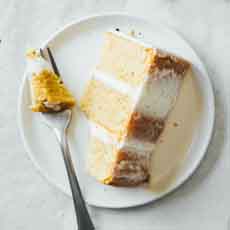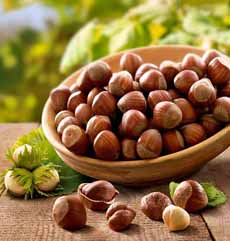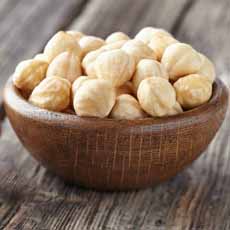RECIPE: Hazelnut Crunch Cake Layer Cake
|
June 1st National Hazelnut Cake Day (see all of the food holidays). We used to make one every year with a delicious, but alas discontinued, white chocolate hazelnut cake mix from The King’s Cupboard (which still makes some of the best chocolate and caramel sauces, including organic and sugar-free varieties). So we had to search for a recipe, and found this stunner by Ashlae of Oh, Lady Cakes, which is dairy free and vegan. Ashlae also does a great job with cookies and other desserts. Take a look at her Facebook photos and decide what you want to bake. We are not handy with frosting, so we shy away from cakes that require the skill. But while this cake is a beauty, it requires only a “naked cake” frosting—a slick of frosting we applied with a spatula. You don’t have to make the hazelnut truffles on top of the cake, either: A sprinkle of hazelnuts will do. (Or, if it’s a party, assign the truffles to someone else.) For the truffle recipe, and more delicious photos, see the original recipe. As they say on The Great British Baking Show: Ready, set, bake! > The history of hazelnuts is below. > The history of cake. Ingredients For The Hazelnut Cake 1. PREHEAT the oven to 350°F. Line the bottom of three round 6″ cake pans with parchment paper; then spray with oil and coat with sifted flour; set aside. 2. SIFT together in a small mixing bowl the flour, baking powder and sea salt; set aside. In a large mixing bowl, combine the oil, sugar, and vanilla extract. |
|
|
|
Alternate between adding the creamer and the flour mixture to the sugar mixture and mixing after each addition; add one-third of the creamer followed by half of the flour and repeat the process ending with the creamer. Whisk batter just until combined (don’t whisk too much or else you’ll overwork the gluten and your cake will be rubbery); then fold in the toasted hazelnuts. 3. POUR the batter into the prepared cake pans, level with the back of a spoon, then tap the pans on the counter to release any trapped air bubbles. Bake at 350°F for 36-40 minutes, or until a toothpick comes out clean. Allow the layers to cool in the pan for about 15 minutes then invert onto a wire rack to cool completely. While the cake layers are cooling… 4. PREPARE the vanilla bean frosting. Ashlae prefers the coconut oil recipe but cautions that it does dry out pretty quickly and is somewhat unstable: It melts if the room temperature is higher than 80°F. Option #2, with shortening, stays soft for a while. 5. ASSEMBLE the cake: Level the layers, then place one layer on a cake stand or plate. Add a generous portion of frosting with a wide spatula. Repeat with remaining layers and frosting. Using an offset spatula, smooth the frosting around the cake. Garnish with the chopped hazelnuts and truffles. Serve, adding one of the remaining truffles to slices that didn’t get one of the garnish truffles. The cake will keep in an airtight container for up to three days. Ashlae cleverly uses a large pot topped off with a silicone lid. The hazelnut, the fruit of the hazel tree, originated in Asia Minor, and is mentioned in Chinese manuscripts dating back 5,000 years. It is also called cobnut or filbert, depending on to species. The European hazel, Corylus avellana, was one of the first temperate shrubs to colonize the land after the retreat of the ice sheets, some 11,700 years ago [source]. In northeastern Europe, hazelnuts were of vital importance from the Mesolithic (Middle Stone Age) into the Bronze Age, 8,000 to 3,000 years ago. In 1995, evidence of large-scale Mesolithic nut processing, some 8,000 years old, was found in a midden pit on the island of Colonsay in Scotland. The nuts were radiocarbon dated to circa 6000 B.C.E. On the other side of the pond, the American hazelnut and the beaked hazelnut were eaten by indigenous peoples on the continent. Mesolithic peoples competed with the wild boar and numerous other mammal and bird species for the nuts. Because hazelnuts are such a rich source of fats, protein, and carbohydrates, they’re an excellent energy source. The Greeks and the Romans spread the cultivation of the nut over Europe [source]. There are references to hazelnuts in ancient Greek and Roman writings. The Greek philosopher Theophrastus (372-287 B.C.E.) described the benefits of hazelnuts, and the Bible lauds hazelnuts for their nutritional and healing powers* [source]. Today, the main producing countries are Turkey (with 70% of global production), Italy, Spain, and the U.S. Ferrero SpA, the maker of Nutella and Ferrero Rocher, uses 25% of the global supply of hazelnuts [source]. ________________ *In Genesis 30:37, “And Jacob took him rods of green poplar, and of the hazel and chesnut tree; and pilled white strakes in them, and made the white appear which was in the rods” (it is spelled that way, with no middle “t.”) [source] CHECK OUT WHAT’S HAPPENING ON OUR HOME PAGE, THENIBBLE.COM. |
||






